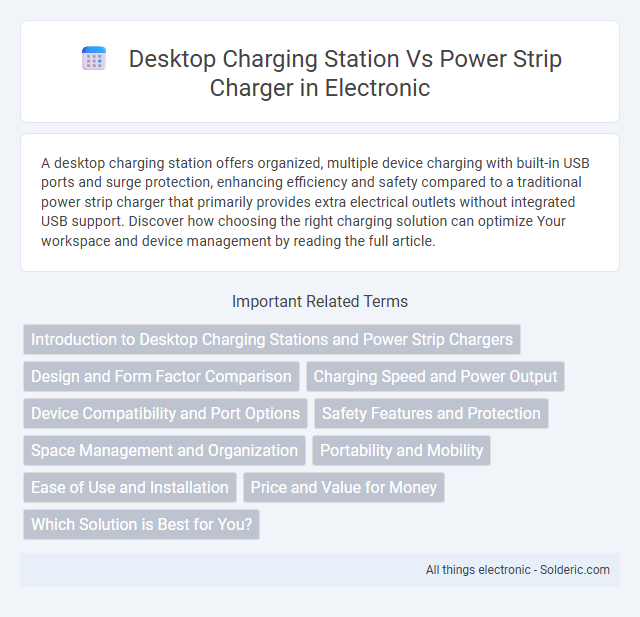A desktop charging station offers organized, multiple device charging with built-in USB ports and surge protection, enhancing efficiency and safety compared to a traditional power strip charger that primarily provides extra electrical outlets without integrated USB support. Discover how choosing the right charging solution can optimize Your workspace and device management by reading the full article.
Comparison Table
| Feature | Desktop Charging Station | Power Strip Charger |
|---|---|---|
| Primary Use | Organized charging for multiple devices on a desk | Multiple power outlets with charging capability |
| Charging Ports | Multiple USB ports, often with fast charging support | Standard AC outlets, some models include USB ports |
| Portability | Compact but designed for stationary use | Generally portable, used for power extension and charging |
| Design | Structured with slots or stands for devices | Strip form factor with multiple sockets in a row |
| Power Management | Intelligent charging with device recognition | Basic power distribution, limited smart charging |
| Safety Features | Overcharge, overcurrent, and short circuit protection | Surge protection available, varies by model |
| Price Range | Moderate to high depending on features | Low to moderate |
Introduction to Desktop Charging Stations and Power Strip Chargers
Desktop charging stations provide a centralized hub for charging multiple devices simultaneously, often equipped with USB ports, wireless charging pads, and surge protection to enhance convenience and safety. Power strip chargers primarily function as electrical outlets with added USB ports, allowing users to plug in several devices and charge them together while protecting against power surges. Both options optimize workspace organization and ensure efficient power distribution but differ in design, capability, and device compatibility.
Design and Form Factor Comparison
Desktop charging stations typically feature a compact, multi-port design that organizes charging cables neatly, reducing clutter on your workspace. Power strip chargers offer a linear layout with multiple outlets suited for larger plugs but often lack the streamlined form factor of dedicated charging stations. Choosing a charging station enhances your desk's aesthetics and functionality by combining USB ports and power sockets in a space-saving design tailored to your device charging needs.
Charging Speed and Power Output
Desktop charging stations typically offer faster charging speeds and higher power output compared to standard power strip chargers due to built-in smart technology like Quick Charge or Power Delivery. They efficiently distribute power across multiple USB ports, ensuring that Your devices receive optimal current without throttling. Power strip chargers may provide multiple outlets but often deliver lower or uneven power output, resulting in slower charge times for high-demand devices.
Device Compatibility and Port Options
Desktop charging stations offer a wider range of port options, including USB-C, USB-A, and AC outlets, ensuring compatibility with smartphones, tablets, laptops, and other electronic devices. Power strip chargers primarily provide multiple AC outlets but often lack advanced USB or fast-charging ports, limiting their ability to efficiently charge modern gadgets. Choosing a desktop charging station enhances device compatibility and flexibility by supporting simultaneous charging across diverse device types and power requirements.
Safety Features and Protection
Desktop charging stations offer advanced safety features such as surge protection, overload prevention, and temperature control to safeguard your devices from electrical hazards. Power strip chargers may provide basic overload protection but often lack comprehensive mechanisms to prevent short circuits or overheating. Choosing a desktop charging station ensures enhanced protection for your valuable electronics, minimizing risks of damage and enhancing overall charging safety.
Space Management and Organization
A desktop charging station offers superior space management by consolidating multiple device chargers into a single, compact unit, reducing clutter and enhancing organization on your workspace. Power strip chargers often consume more surface area and result in tangled cords, making efficient cable management a challenge. Optimized design features of charging stations, such as designated slots and USB ports, streamline device placement and ensure a tidy, organized charging environment.
Portability and Mobility
Desktop charging stations offer greater portability and mobility compared to traditional power strip chargers due to their compact design and built-in cable management features. Many desktop charging stations include multiple USB ports and wireless charging pads, allowing users to charge various devices simultaneously without bulky adapters. Power strip chargers tend to be heavier and less convenient to move, making desktop charging stations ideal for users who require efficient charging solutions on the go.
Ease of Use and Installation
A desktop charging station offers streamlined ease of use with built-in USB ports and wireless charging pads, reducing cable clutter and making device access straightforward. Power strip chargers require manual plug-in of multiple adapters, which can be time-consuming and less organized, but provide flexibility with varied outlet types. Your choice depends on prioritizing hassle-free setup or versatile device compatibility.
Price and Value for Money
Desktop charging stations often offer higher upfront costs compared to power strip chargers but provide superior value for money through integrated smart charging technology and multiple USB ports, reducing clutter and enhancing convenience. Power strip chargers are typically more affordable but may lack advanced features and efficient power distribution, making them less cost-effective for users with several devices. Your investment in a desktop charging station ensures better durability and faster charging speeds, ultimately maximizing long-term savings.
Which Solution is Best for You?
A desktop charging station offers streamlined organization with multiple USB ports and wireless charging options, ideal for keeping your devices in one convenient location. Power strip chargers provide versatility by combining standard outlets with USB ports, making them suitable for various device types and larger setups. Your choice depends on the number and type of devices you need to charge, as well as your space and portability preferences.
Desktop charging station vs power strip charger Infographic

 solderic.com
solderic.com